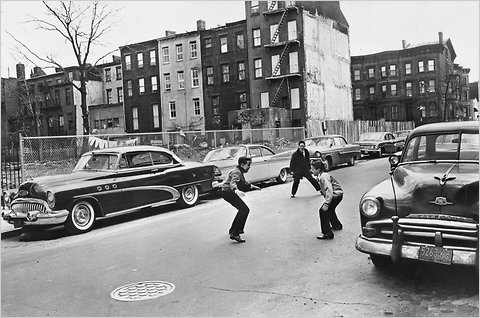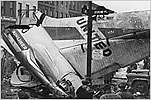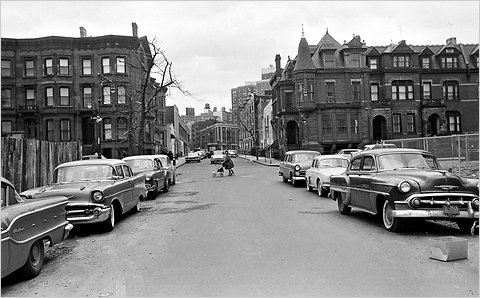 Meyer Liebowitz/The New York Times Sterling Place, just west of Seventh Avenue, in 1961.
Meyer Liebowitz/The New York Times Sterling Place, just west of Seventh Avenue, in 1961.Edwardian and Victorian row houses were scarred with peeling paint, broken windows and missing stoop stones. Scavengers pilfered abandoned or burned-out homes for radiators and brass pipes to sell as scrap metal. Residents called a group of rat-infested buildings on Prospect Park West a “serious blight” and a breeding place for “prostitution, crime, vice, narcotics and immorality.”
December 16, 1960
Horror in the Sky

Remembering the day when two airplanes collided over the city and crashed in Brooklyn and on Staten Island.
In 1960, The New York Times called Park Slope a neighborhood “in transition.” (pdf) But residents who were there, or had grown up with the Tigers and the Garfield Boys, the roaming teen gangs described in Pete Hamill’s memoir “A Drinking Life,” might say that the newspaper’s description was generous.
“It was a neighborhood seriously in trouble,” said the former State Assemblyman Joe Ferris, who also served as the president of the Park Slope Civic Council. One of the worst areas, Mr. Ferris said, was a stretch of row houses on St. John’s Place that looked as if it had been bombed with heavy artillery.
That was the Park Slope where a mortally damaged jet came to rest on Dec. 16, 1960, after hitting another passenger plane over Staten Island. It was a place both similar to and remarkably different than today’s neighborhood of restored brownstones; indeed, to those who lived there 50 years ago, the Park Slope of today is nothing short of a miracle.
Back then, one wary store owner, a florist on Flatbush Avenue, kept a can of lye behind the counter to protect herself in the event of a robbery. (pdf)
The predominantly Irish and Italian middle-class residents were feeling the squeeze of a countrywide economic downturn. Banks had red-lined the area, citing underground streams and a lack of off-street parking as reasons not to lend. The Federal Housing Administration was not backing mortgages in the whole borough, which meant that even middle-class couples looking to buy could not get financing. Lured by the promise of a cheap house with a yard for their children and a driveway for their car, many families migrated to Long Island. Many of the managers at Dime Bank, the Williamsburg Savings Bank and others lived out there, too.
“Brooklyn was, in their mind, the land of crime, gangs and arson,” Mr. Ferris said.
 Meyer Liebowitz/The New York Times Sterling Place near Seventh Avenue after the plane fell, 1961.
Meyer Liebowitz/The New York Times Sterling Place near Seventh Avenue after the plane fell, 1961.Speculators — also called “blockbusters” — were eager to buy up single-family homes and chop them into smaller units for rent. Some buildings were divided into as many as eight units, with parents and children packed into half a floor. Shaken residents who were afraid of changes in the neighborhood were coaxed, or even scared, into selling their homes by agents who ominously suggested they should get out before things got even worse.
“There was still a great deal of racism in our society and it was an easy card to play, particularly with some of the older people here who had never had any experience with integration,” said Bill Jesinkey, a former school teacher who was active in several neighborhood groups that worked closely with the civic council. “The idea that there wouldn’t be all white families on the block was a completely new idea.”
According to the Department of City Planning, 93.4 percent of the population was white. The median family income was $5,782 ($43,457 in 2010 dollars), which was slightly lower than the Brooklyn average. And only 18 percent of residents owned their homes, compared with about 33% in 2000.
Construction workers, teachers and secretaries worshiped beside the white-collar accountants, lawyers and judges who also lived there. Churches kept their doors open, even on weekdays, and Sunday services were so crowded that latecomers were relegated to the stoop. They organized dances and acted as facilitators for the neighborhood.
Tom Miskel, who grew up on Eighth Street near Seventh Avenue, recalled how priests at St. Francis Xavier engaged teenage troublemakers, in particular, ones that were setting fire to dry pine trees after their owners had thrown them out after Christmas, with activities like community service and fund-raisers for the church.
 Meyer Liebowitz/The New York Times. Seventh Avenue looking toward Sterling Place in 1961.
Meyer Liebowitz/The New York Times. Seventh Avenue looking toward Sterling Place in 1961. But there were perhaps even more bars than churches in the neighborhood, particularly along Seventh Avenue. Louis Poggioli, born in northern Italy, served a middle-aged clientele for 24 years at his tavern, James’s, on Seventh Avenue. He recalled pouring drinks for Hugh L. Carey, who was elected to the United States House of Representatives in 1960 and later became governor, at 2 a.m. Mr. Poggioli did not allow babies in his bar. He did not even like serving the younger folk.
“They don’t spend money,” he explained.
When the plane came down, cartwheeling up Sterling Place, destroying a church and several buildings, it was a psychological blow to the community. “You shook your head,” Mr. Ferris said.
Residents of that Park Slope who are still alive today winced at a sub-headline that appeared in The New York Times on Dec. 17:
“Sterling Place, An Area of Run-Down Houses, Ripped Asunder by Crashing Plane.”
Coming on Tuesday: How it happened: inside the cockpits of the doomed airliners, and with the air-traffic controllers who watched the horror unfold.

Comments are no longer being accepted.